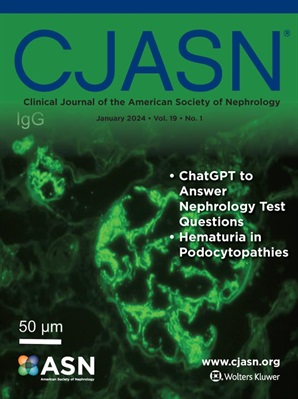泌尿生殖系统病理异常亚群中SGLT-2抑制剂尿路感染的风险
IF 8.5
1区 医学
Q1 UROLOGY & NEPHROLOGY
Clinical Journal of the American Society of Nephrology
Pub Date : 2025-04-11
DOI:10.2215/cjn.0000000687
引用次数: 0
摘要
背景:虽然钠-葡萄糖转运蛋白-2抑制剂(SGLT2i)具有多种有益作用,但这些药物与泌尿生殖系统感染有关。我们试图确定SGLT2i暴露、尿路感染(UTI)类型和临床危险因素之间的确切关系。方法采用事件用户设计和主动比较分析,从美国全国保险索赔数据中获得SGLT2i和胰高血糖素样肽-1受体激动剂(GLP1ra)用户队列。我们使用协变量校正Cox模型和治疗加权逆概率Cox模型来调查药物暴露后非念珠菌UTI和念珠菌UTI的风险。我们比较了普通人群和泌尿生殖系统异常亚人群中SGLT2i和GLP1ra暴露的风险。结果glt2i暴露与GLP1ra暴露相比,假丝酵菌UTI风险更高(所有危险比[hr]≥2.42,所有p值<0.001),而非假丝酵菌UTI风险更低(所有hr≤0.91,所有p值<0.001)。既往泌尿生殖系统异常,如既往UTI、既往生殖器感染、泌尿生殖系统恶性肿瘤、留置foley或其他泌尿生殖系统病理与非念珠菌和/或念珠菌UTI的高风险相关(调整后hr≥1.26,p值≤0.002)。然而,在这些亚群中,未观察到SGLT2i与GLP1ra暴露对非念珠菌UTI的比较风险差异。相比之下,在念珠菌UTI中观察到SGLT2i暴露与几种泌尿生殖系统异常之间的叠加效应(所有调整后的hr≥2.37,所有p值<0.001)。结论ssglt2i暴露与念珠菌UTI风险增加相关,但与非念珠菌UTI风险无关。与没有泌尿生殖系统病理异常的个体相比,SGLT2i和GLP1ra非念珠菌尿路感染的比较风险没有差异。本文章由计算机程序翻译,如有差异,请以英文原文为准。
Risk of Urinary Tract Infections with SGLT-2 Inhibitors in Subpopulations with Abnormal Genitourinary Pathology.
BACKGROUND
While sodium-glucose transport protein-2 inhibitors (SGLT2i) possess multiple beneficial effects, the drugs are associated with genitourinary infections. We sought to define the precise relationship between SGLT2i exposure, types of urinary tract infections (UTI), and clinical risk factors.
METHODS
We used an incident user design with active comparator analysis to derive SGLT2i and glucagon-like peptide-1 receptor agonist (GLP1ra) user cohorts from US nationwide insurance claim data. We used both covariate-adjusted Cox models and Cox models with inverse probability of treatment weighting to investigate the risk of non-candida UTI and candida UTI following drug exposure. We compared the risk between SGLT2i and GLP1ra exposure in the general population and subpopulations with genitourinary abnormalities.
RESULT
SGLT2i exposure compared with GLP1ra exposure was associated with a greater risk of candida UTI (all hazard ratios [HRs] ≥2.42 and all P-values <0.001), but a lower risk of non-candida UTI (all HRs ≤0.91 and all P-values <0.001). Prior genitourinary abnormalities such as prior UTI, prior genital infection, genitourinary malignancy, indwelling foley, or other genitourinary pathology were associated with greater risk of non-candida and/or candida UTI (all adjusted HRs ≥1.26 and all P-values ≤0.002). However, no difference in comparative risk of SGLT2i to GLP1ra exposure for non-candida UTI was observed in these subpopulations. In contrast, an additive effect between SGLT2i exposure and several genitourinary abnormalities was observed for candida UTI (all adjusted HRs ≥2.37 and all P-values <0.001).
CONCLUSIONS
SGLT2i exposure was associated with greater risk of candida UTI, but not non-candida UTI. SGLT2i to GLP1ra comparative risk of non-candida UTI did not differ in individuals with abnormal genitourinary pathology compared to those without.
求助全文
通过发布文献求助,成功后即可免费获取论文全文。
去求助
来源期刊
CiteScore
12.20
自引率
3.10%
发文量
514
审稿时长
3-6 weeks
期刊介绍:
The Clinical Journal of the American Society of Nephrology strives to establish itself as the foremost authority in communicating and influencing advances in clinical nephrology by (1) swiftly and effectively disseminating pivotal developments in clinical and translational research in nephrology, encompassing innovations in research methods and care delivery; (2) providing context for these advances in relation to future research directions and patient care; and (3) becoming a key voice on issues with potential implications for the clinical practice of nephrology, particularly within the United States. Original manuscript topics cover a range of areas, including Acid/Base and Electrolyte Disorders, Acute Kidney Injury and ICU Nephrology, Chronic Kidney Disease, Clinical Nephrology, Cystic Kidney Disease, Diabetes and the Kidney, Genetics, Geriatric and Palliative Nephrology, Glomerular and Tubulointerstitial Diseases, Hypertension, Maintenance Dialysis, Mineral Metabolism, Nephrolithiasis, and Transplantation.

 求助内容:
求助内容: 应助结果提醒方式:
应助结果提醒方式:


